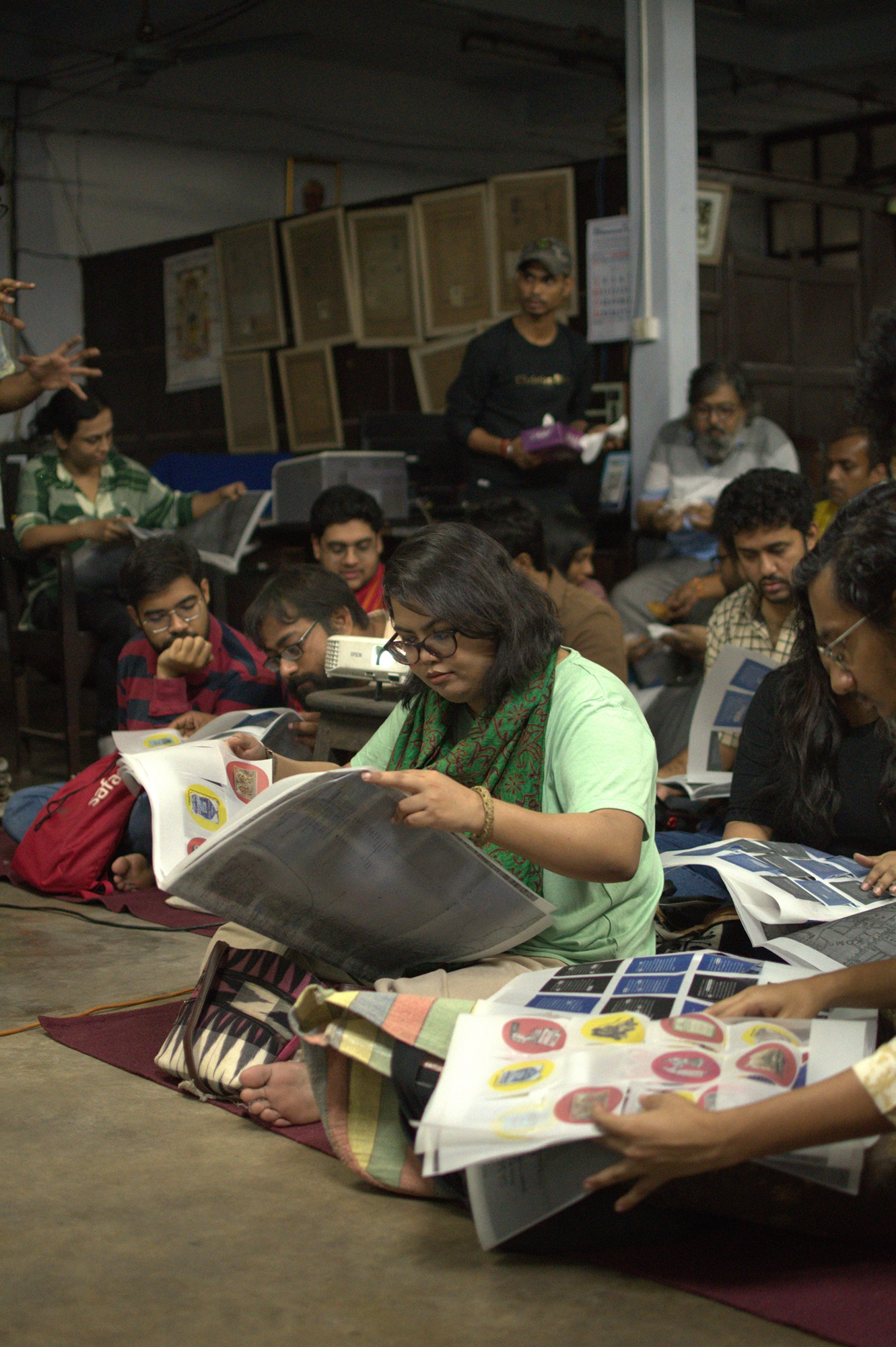Stories of Dissent: The City as a Museum 2024 Part 1The Editorial Team December 01, 2024 DAG's annual festival returned for a fourth edition in November 2024, as we navigated various sites,repositories and neighbourhoods in Kolkata by exploring visual testimonies, artistic practices and lineages, to rediscover the transformative potential of peripheral narratives. In this edition of the festival we travelled across different spaces and neighbourhoods of the city to find the small narratives and counter-memories that have shaped the city through its art. Find out more about the programmes in our two-part photo-essay. |

Chittaprosad
Untitled
Linocut on paper, 7.7 x 13.7 in.
Collection: DAG
|
This year our focus for the fourth edition of ‘The City as a Museum’ is on highlighting communities and practices of subversion and dissent within the urban landscape, creating intersections that challenge a singular, dominant view. To address this theme, we are exploring the involvement of artist-activists such as Chittaprosad, Somnath Hore, Zainul Abedin and others in political upheavals, situating figures like F.B. Solvyns within the colonial hierarchies of European communities in Calcutta, navigating the city through street directories and vernacular cartographic practices, examining alternative pedagogical approaches that emerged outside the confines of the colonial art institutes and exploring the polyphonic terrain of Indian Classical Music in the late nineteenth and early twentieth centuries and the pivotal role of courtesans and their kothas in disseminating Indian Classical Music. |
|
|



An Exhibition on the Tebhaga MovementA key highlight this year was our pop-up exhibition at the Directorate of State Archives on the Tebhaga Movement of 1946. This display of artworks and archival materials sought to explore the dialogue between testimonies of artists-activists like Chittaprosad and Somnath Hore consisting of artistic reportage, diary entries and official records like confiscated newsprints, history sheets, representing the state’s surveillance of a growing agrarian movement—constituting the ‘prose of counter-insurgency’ that Ranajit Guha famously identified. The exhibition was open throughout our one-week festival and hosted multiple sessions to activate and enrich the narratives foregrounded by the display and to generate additional perspectives. Archival materials were sourced mostly from DAG’s archives around Somnath Hore’s sketches featured in his Tebhaga Diary and contributions by Chittoprosad in newspapers like ‘People’s War’. Alongside this, the Ganashakti and CSSSC archives in Kolkata and P. C. Joshi Archives in New Delhi further helped us incorporate supporting materials to present a rounded discourse about the ‘Tebhaga Movement’. |
|
|




From Mappa to ManchitraHow do we make our way in the city? Do we have a mental image of the route we have to take? What kind of aids do we make use of when we do not know the way? Do these aids—maps, directories, limericks—reshape the way in which we imagine the city? These were questions that were explored as participants congregated for the ‘Mappa to Manchitra’ event. While colonial administrators mapped the city according to their needs and power relations, towards the end of the nineteenth century new vernacular maps were emerging that highlighted different prerogatives for spatial mapping by the local inhabitants who inhabited those spaces. Some of these were published by the iconic press run by P. M. Bagchi, whose street directories inspired us to find sources that were already writing back to the Empire. Through a walk around the neighbourhood of the P. M. Bagchi press, taking in the various ways in which the directory’s descriptions of street-names and iconic residences were drawn from local knowledge-systems, we eventually moved on to a discussion and presentation on the evolving modes of cartography—revealing a parallel set of methods and processes that were always present as silent interlocutors of dominant practices. |
|
|



The White OtherFor The White 'Other’ we traced the stories of those living outside the remit of the society of Company-sanctioned Europeans enjoying the opportunities and treasures of Empire. Anchored around the figure of Baltazard Solvyns, a European marine painter who had travelled to South Asia without such legal permits, the programme recounted stories of marignalisation that white Europeans frequently faced during their stays in the colonies. By 1791, when Solvyns arrived in India, artists such as Tilly Kettle, John Zoffany, William Hodges, and the Daniells, had already established themselves in India. However, they had official sanction to live in India in the form of a Company permit. This would prove to be crucial determinant of their chances at success or failure. Stories were told of European artists who never found the success they were looking for and were subsequently forgotten about. But it was suggested that Solvyns' lack of wealthy patronage and his limited residential access to 'White Town' gave him leave to access parts of the city unfrequented by Europeans. He created a visual record of all the various ethnic groups he came across in Calcutta and their way of life, which is valued as one of the first visual ethnographic records of the people of Calcutta by a European. |
|
Dissensus refers to a state of disagreement, discord, or conflict, especially within a society or group. It is the opposite of consensus, where there is general agreement or harmony. The term is often used in political theory and philosophy to describe a situation where differing or opposing viewpoints, values, or interests clash, challenging dominant narratives or accepted truths. Our effort through this year’s festival was to highlight such narratives that pose questions to commonly accepted versions of history. These dissensual views are not just records of resistance, but alternative aesthetic possibilities that have occupied some of the finest modern artists of our time—who have had to work through the passages of history. In the next part of this photo-essay, we will explore some of the other narratives that were explored through this year’s festival, ‘The City as a Museum’. |
|
|


